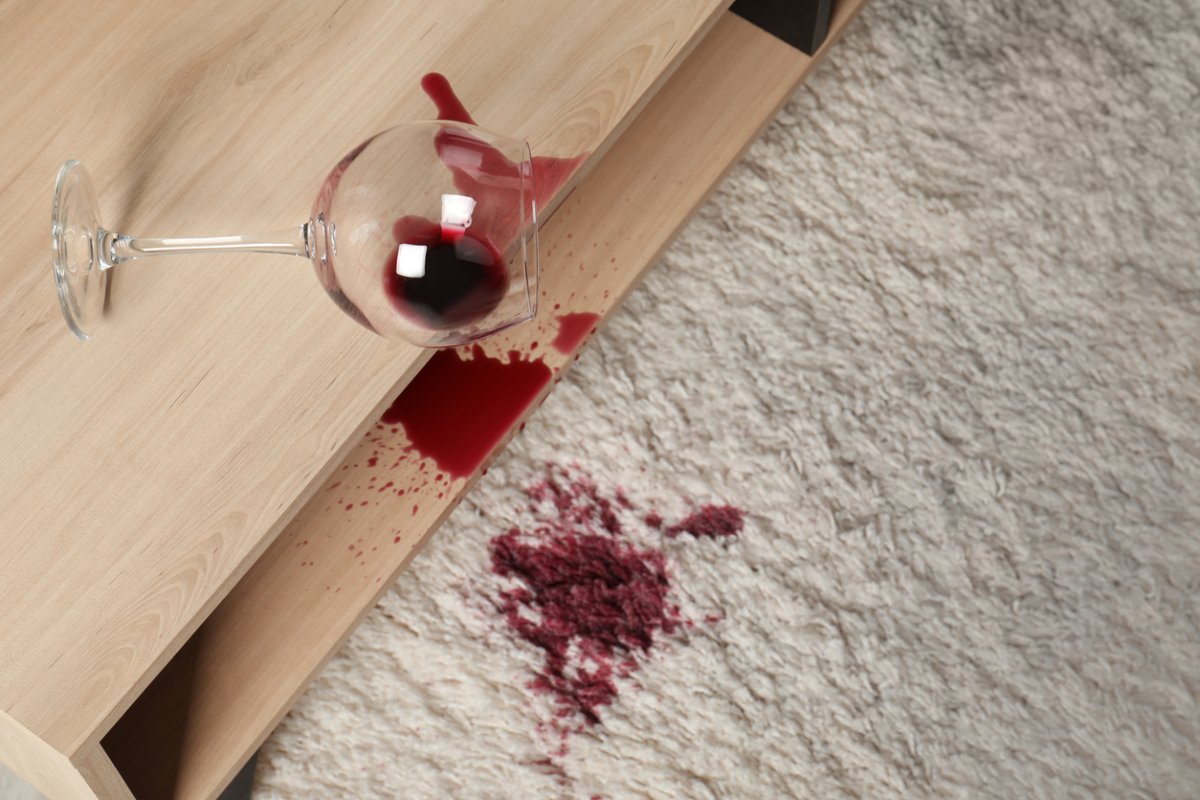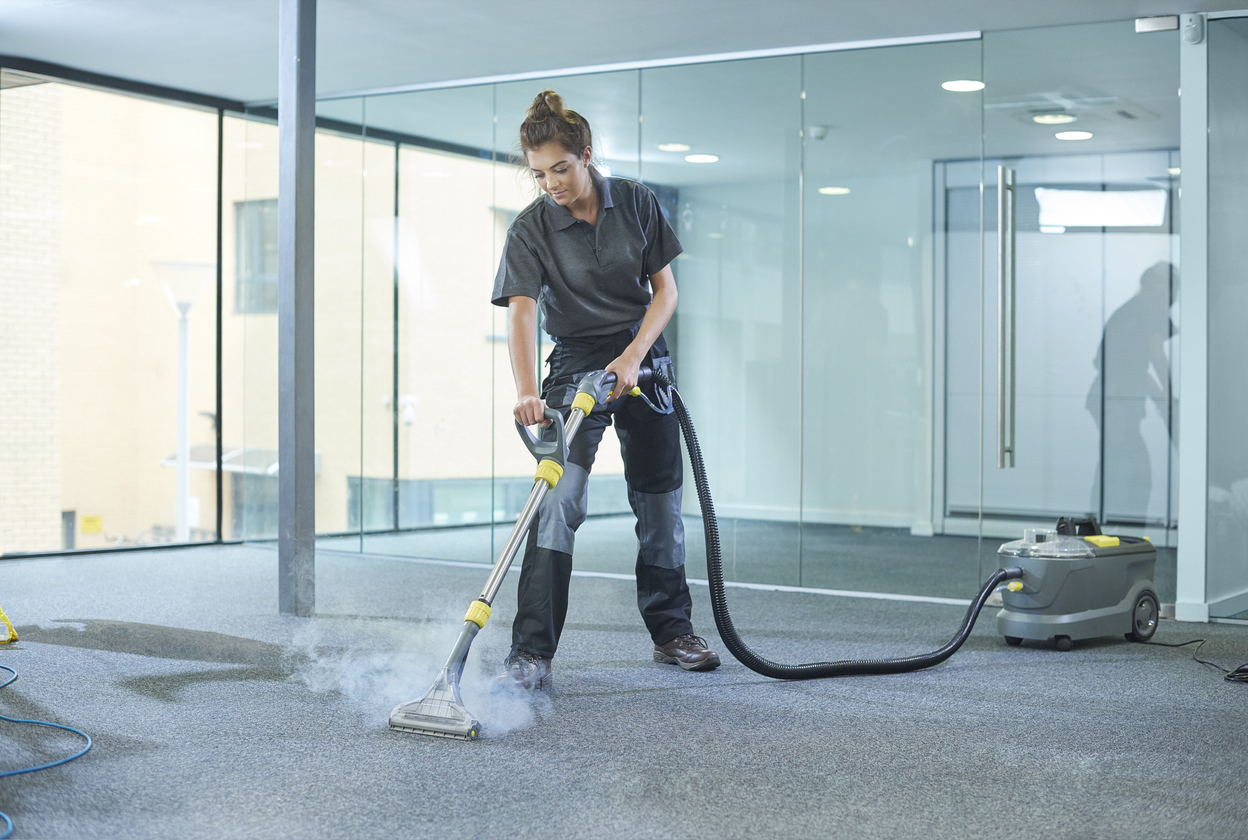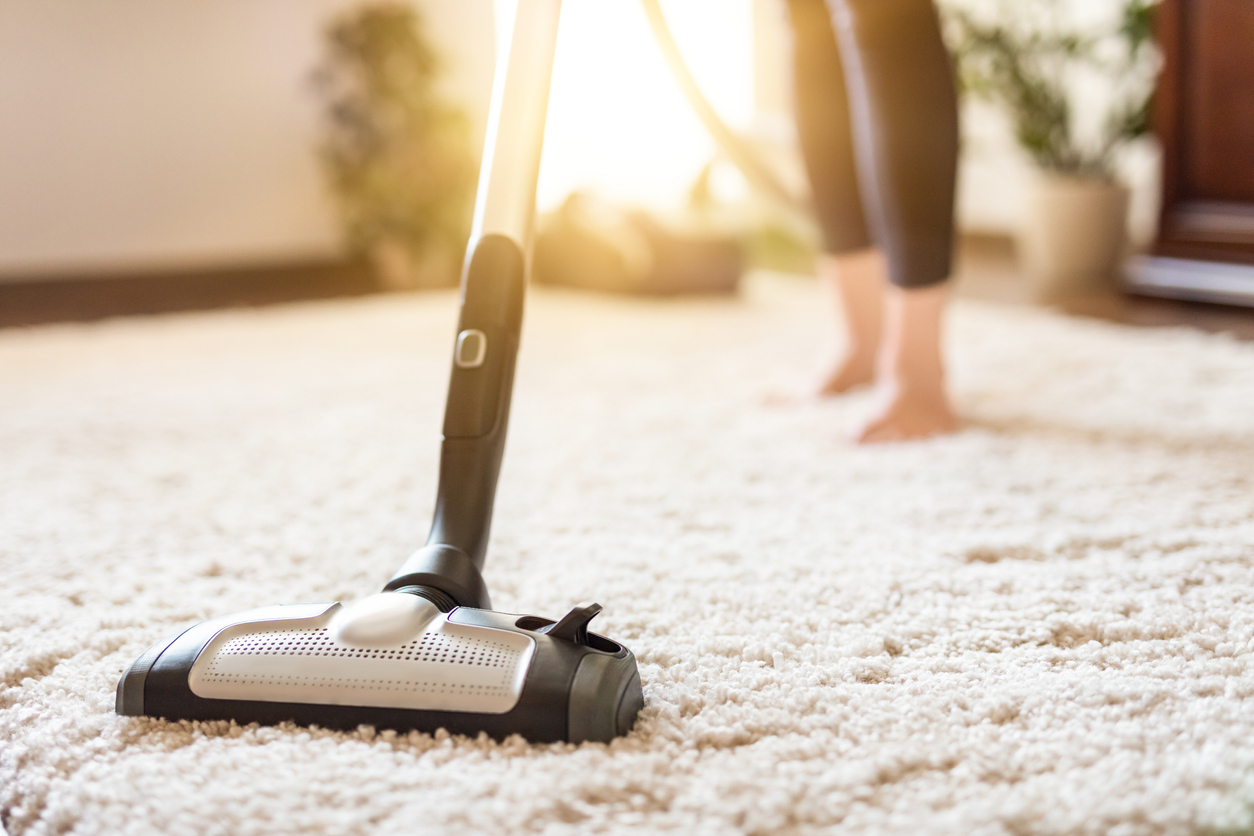

We may earn revenue from the products available on this page and participate in affiliate programs. Learn More ›
Our carpets suffer the collateral damage of our busy, active lives. The daily foot traffic and those inevitable spills and stains guarantee they will need regular cleaning. The good news is that a hot water extractor, a machine specially designed for deep restorative carpet cleaning, can attack deeply embedded dirt and grime to keep carpets as pristine as the rest of the décor.
Of all of the machines available to homeowners for cleaning carpets with commercial shampoo—including shampooing machines and buffers with solution-moistened pads attached—hot water extractors are today’s gold standard for a deeper, long-lasting cleaning.
Once you know how to use a carpet cleaner, shampooing dirty carpets once a year (or more frequently, if your carpets are stained or heavily soiled synthetic carpets) can keep them looking and smelling great. Warm water mixed with an appropriate shampooing solution can even remove stubborn substances like ketchup, coffee, wine, pet urine, and ink. Read on to learn how to shampoo carpets.
Tools & Materials
Bobvila.com may earn a commission from purchases made through these links.
Before You Begin
Before you start cleaning, let’s talk about semantics. You may hear the terms “hot water extraction” and “steam cleaning” used interchangeably when it comes cleaning carpet, but in reality these are two completely different cleaning methods. A steam cleaner uses—surprise!—steam along with shampoo. Critics claim that steam cleaning can actually worsen stains and damage carpet fibers, so it is more widely recommended for hard surfaces.
Hot water extraction, on the other hand, forces a mixture of hot water (though not quite steaming) and carpet shampoo deep into the carpet. The solution and dirt are then extracted from the carpet, leaving the fibers and carpet base clean.
Choosing the Right Carpet Shampoo
Every carpet shampoo is different, and you shouldn’t use just any carpet cleaning product for a deep clean. Always read the product label prior to purchasing a carpet shampoo. The right cleaning agent helps get the best clean for your carpet material, type of stains, and carpet extractor.
Products touted as shampoo for carpet should list the types of fabrics for which they are designed. If you don’t see this information on the label or the manufacturer’s website, choose a different product. The shampoos should also list which brands of machines they’re compatible with for best results.
There are three main types of carpet shampoo:
- Dry carpet shampoo: These dry or powder-based shampoos are used with a regular vacuum cleaner. Before vacuuming, sprinkle the dry shampoo on the carpet, brush it in to activate the particles that lift dirt and smells, and then vacuum it up. Dry carpet shampoo can be as effective as traditional liquid shampoos for eliminating odors and cleaning tough organic stains.
- Traditional carpet shampoo: These liquid shampoos perform best when used with a carpet extractor or other carpet-cleaning machine. These machines use a mixture of hot water or steam along with the liquid detergent while suctioning dirt and debris. When diluted properly these products are typically low-foaming formulas, and effective at cleaning deeper into carpets and rugs.
- CRI carpet shampoo: The Carpet and Rug Institute (CRI) has a testing program that identifies superior carpet-cleaning machines and solutions. CRI shampoos have been tested for soil removal efficacy, resoiling, residual moisture, surface appearance change, colorfastness, pH level, and optical brighteners.
Read to learn how to shampoo carpets using this deep-cleaning machine.

STEP 1: Pick up your hot water extractor.
First order of business: Acquiring the equipment. Deciding whether to rent or buy a hot water extractor rests on your projected usage. Prices to buy are all over the map—from under $200 up to $4,000 for bigger, more powerful models—depending on the bells and whistles included. For most consumers who devote one day to the task, rental is the more cost-effective option. Renting a carpet extractor from Home Depot in the New York City area costs about $79 per day, but the cost may vary by region.
Whether you rent or buy a carpet extractor, be sure to select a machine that is approved by the Carpet and Rug Institute (CRI). Representing carpet manufacturers nationwide, the CRI tests machines for effectiveness and those that qualify are labeled with a bronze, silver, or gold certification.
Once you’ve chosen your cleaning device, read the operating directions carefully. Use only a commercial carpet shampoo with a CRI seal of approval, and make sure the brand compatible with your particular extractor. Do not add any other chemicals to the mix or under-dilute the cleaning solution in an attempt to make it stronger.
Carpet extractors can be pretty loud, so we recommend wearing hearing protection when the machine is in use.
STEP 2: Clear your space and scope out stains.
Before you even press the start button on the extractor, clear the room to expose as much carpet as possible. Take a little time to notice and address smaller tough stains using a stain remover spray. The cleaner is sprayed directly on the stain and then either vacuumed up or dabbed with a clean cloth, depending on the product’s recommendations.

STEP 3: Vacuum the carpet.
Run your trusty vacuum cleaner over the entire open space before you bring in the heavy machinery. This once-over will remove loose dirt as well as any gravel or sand that has been tracked into the house. Vacuuming will fluff the carpet fibers and loosen dirt trapped deep within, making your cleaning effort much more effective.
A good pre-shampoo vacuuming will also give you an opportunity to spot and pick up those little items—like rubber bands, hair accessories, and paper clips—that can jam the hot water extractor.
STEP 4: Fill your machine with carpet shampoo and water.
A basic hot water extractor is a self-contained, 2-tank unit. One tank holds the clean water mixed with commercial carpet shampoo. The other tank holds the dirty water, and fills up as you shampoo. Fill the clean water tank with the exact amount of water and carpet shampoo specified. Do not use more shampoo than stipulated—if you do, the solution won’t dissolve well and will leave residue on the carpet that will act as a dirt magnet.
Once you have set up the machine’s fresh and dirty water reservoirs according to the manufacturer’s instructions, you are ready to begin cleaning. Start in a far corner of the room and slowly walk forward, pressing the button on the handle to gently release the carpet shampoo onto the rug. The vacuum runs as long as the machine is turned on and will suck up the residual dirty, sudsy water as you go.
Here are a few pro tips for carpet shampooing:
- Before you expose your entire carpet to any chemical solution, test the hot water extractor on an inconspicuous corner to make sure the carpet shampoo solution will not affect the color or damage the surface.
- Do not use hot water to clean natural materials since it will shrink and destroy the fibers. For wool carpets, fill the machine with cold water instead of hot. Use hot water with synthetic carpet only.
- For best results, do not hold the water-release button down continuously but instead press intermittently to keep from flooding the carpet with excess water. Drowning the carpet will definitely increase drying time and could potentially lead to subsequent mold issues.
RELATED: The Best Carpet Cleaning Companies, Vetted
STEP 5: Clean until the extracted water runs clear.
Continue working from one wall to the other until the water the machine extracts appears clear. Empty the waste water tank and refill the clean water tank with solution as needed.
STEP 6: Allow the carpet to dry completely.
How long it takes carpets to dry after shampooing with a hot water extractor depends on the size of the room, type of carpet, thickness of the padding, amount of dirt addressed, and ventilation. Four to 6 hours of drying time is a good rule of thumb for an average size room with good ventilation, but some carpets may take anywhere from 8 to 24 hours to fully dry. Beware of wood furniture coming into contact with wet carpeting; when wet, dyes from the wood stain can be released onto the carpet and create lasting marks.
If you’ve only rented the hot water extractor for one day and you have an entire house of dirty carpets to tackle, time is of the essence. While one room is drying, empty out the waste water tank, refill the clean water tank with diluted carpet shampoo and move on to the next space.

STEP 7: Vacuum one last time to remove residue.
Once you are sure the carpet pile is well and truly dry, run the vacuum cleaner to remove any traces of leftover cleaning residue. Now all that is left is to do is enjoy the clean fruits of your labor!
Final Thoughts
Our guide on how to shampoo carpets gives you a tried-and-trusted method for ensuring your carpets are clean.
The best way to make sure you clean your carpets properly is to take your time. Moving the extractor slowly over the carpet gives it more time to drive the cleaning solution into the carpet fibers and suction the foam and dirt out.
Remember to always use carpet shampoo as directed. Too much solution creates excess foam, which is what pulls the dirt from the carpet. If foam is left on the carpet, more dirt will be left behind.
Check your water tanks periodically. If the cleaning solution runs low, you need to stop cleaning to replace it. Otherwise, you’ll be running the machine over the carpets but not actually cleaning them.
One last thing: Carpet cleaners are heavy and loud. To avoid straining yourself, take care when lifting them up and down stairs. We also suggest wearing hearing protection to prevent inner ear damage.

FAQs
Yes, you should keep going over the carpet with the extractor until the water becomes clear. When you see dark water in the collection tank, that’s the dirt coming out. The more people or pets walk over the carpet–even without shoes–the more dirt gets trapped in the carpet fibers.
In general, carpets take anywhere from 8 to 12 hours to dry completely, but it can take longer. Damp ,shampooed carpets can dry faster with more air circulation. On hot, dry days, opening a window can help dry your carpets faster. Cold air or high levels of humidity cause carpets to dry more slowly.
You might have to rinse your carpets afterward, depending on the machine you’re using. Most water extractors are designed to remove the shampoo and water from the carpet as you clean, which eliminates the need to rinse again with cold water afterward.
You should aim to shampoo your carpets at least once a year. For carpets that get high traffic use, or are in homes with pets or children, deep cleaning more often is a good idea. In these instances, every 6 months is a more suitable cleaning schedule for shampooing your carpet.
Hot water is better for cleaning carpets because it’s more effective at dissolving substances like caked-on messes. The molecules in hot water move faster, which creates more space between molecules that can be filled with dissolved solvents. Additionally, when soap—in this case, carpet shampoo—mixes with hot water, it’s more effective at lifting dirt. The exception here is wool: Use cold water when cleaning wool carpets.
